|
|
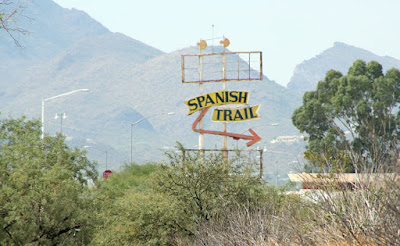 Just what is the Spanish Trail? Between 1838 and 1849 a trail from Santa Fe, New Mexico to Los Angeles became heavily traveled by traders and others who wished to go West.
The trail curves north from Santa Fe into Utah. Travelers had to avoid a more Southern route because of hostile Indian tribes.
People from New Mexico brought wool west to California to trade for horses. Then they went back east to sell the horses in Santa Fe.
In the 1840s, the Mormons used the trail, establishing it as a major wagon route so that they could move back and forth from Utah settlements to California.
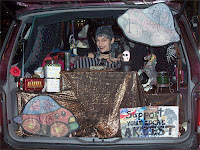 I lived in San Francisco for 18 years and, take my word, every day was Halloween. Many People with multi-colored hair and a ring for just about every part of their body. And, down in the Tenderloin neighborhood everybody's got a bottle or can with a paper bag over it. In the Castro, wealthy gay people shop at Pottery Barn. In the Haight, you can be a hippie all over again (that is if you're old enough to have done it the first time). In the marina, you can go shopping for a date at the Safeway. And in Pacific Heights, every Victorian is haunted (or should be, at least on Halloween!).
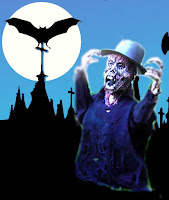 I don't know about you, but I like a good scary picture on Halloween. You can go on the Internet and into Google images to get any kind of pictures you want and make a collage from them in Photoshop. left, for example. All I used here was two pictures, the scary monster coming from the ground and the scary background (which I cropped tightly to make the monster pop out). Here's the Photoshop tools I used: 1. Open Photoshop and click on File>New
2. Set the size to 6 inches by 6 inches at 300 ppi.
3. Click and drag a background image found to the open file in Photoshop.
4. Go back to Google images and find a picture to click and drag over the background.
5. Smooth out excess background from the picture pasted onto new background by selecting it, then clicking on Select>Inverse and then clicking delete. (You'll cut out the background of of the picture you pasted on the new background so it matches the background you got off of Google.)
6. Use the blur tool to smooth edges on pasted pic that's on new background.
 An orchid in Quito, Ecuador An orchid in Quito, Ecuador
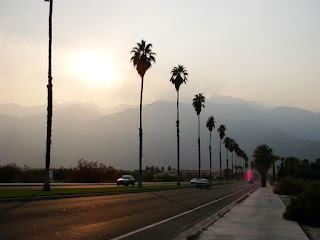 Cough, cough all day long. Eyes watering, stinging. As the wind changed direction from east to west, so did the California wildfire. The smoke reached Palm Springs (see picture above). It was an eerie day, felt surreal, like I was floating on top of my bicycle when I went for a ride at dusk. The air was thick, yet dry; the sun eclipsed by silvery fumes. Fire, indeed, creates smoke, which nature takes for ride, clear across the mountains up in the sky.
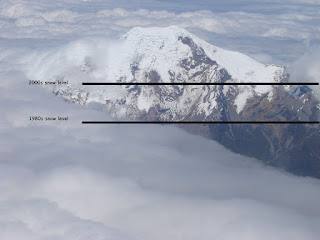 When you fly from Quito to the Amazon in Ecuador you pass by Ecuador's highest peak, Chimborazo (20,702 feet). Global warming has eliminated much of the snow pack at the top. I had a chance to talk to an underwater photographer who's been flying that route for decades, noticing global warming's effect on the snow pack of the mountain. He's noticed a visible retreat he thinks is due to global warming of the snow line about the distance marked in the picture above. Other data has supported the drastic disappearance of snow and ice in the Andes caused by global warming. Here's other evidence that the ice in the Andes is disappearing: * Qori Kalis, a glacier in Peru retreat rate was 13 feet/year in the 60s. Global warming has caused it to accelerate to over 100 feet/year (estimated) today.* Quelccaya ice cap in the Southern Andes has shrunk by 20 percent since the 60s, and, it is believed the cause is global warming.* The number of glaciers in the Venezuelan Andes has gone down from 6 to 2 since the 70s, possibly due to global warming.* Temperatures in the Andes have warmed by .6 F since the 70s--believed to be caused by global warming.* The ice cap on the peak of Cotacachi in Eucador, which up until a few years ago had been there for eons, has melted away.* Global warming is believed to cause 80 percent of the glaciers in Bolivia to melt. If anyone in the United States congress dares to say that global warming does not exist, he should be impeached on the spot. Photograph was taken by Matt Bamberg (that would be me) earlier this year, copyright 2007.
 Galapagos hawk perching itself a top of the national park sign Galapagos hawk perching itself a top of the national park signThe Galápagos Hawk is one of the few animals that hunts for prey on the islands. It's a small hawk, only about a foot tall. One female will mate with four males in order to breed. All of the males will assist in taking care of the young. The Galápagos Hawk eats iguanas, mocking birds and some insects that live on the islands. The bird also feeds on carcasses of marine mammals and sea birds.
 Waterfowl on the shore of Lake ArrowheadTen Facts about Lake Arrowhead Waterfowl on the shore of Lake ArrowheadTen Facts about Lake ArrowheadLake Arrowhead is a resort community in the Inland Empire of California. Lake Arrowhead is 5,100 ft. above sea level. The median income of residents there is $78,000 a year In 2003, Lake Arrowhead had massive wildfires. Lake Arrowhead is a few miles from Running Springs, where the wildfires of 2007 are occurring. The population of Lake Arrowhead is about 9,000. Most people who live there are white (90 %). The median home price in Lake Arrowhead is $500,000 The median age in Lake Arrowhead is 37.8. There are 6 movie theaters within 15 miles of Lake Arrowhead
 Photograph of Malibu brush before the fire. Photograph of Malibu brush before the fire.Fires in Malibu are part of a cycle of vegetation growth. There have been fires there throughout the 20th century. The vegetation that grows in Malibu is Chaparral brush--over 2000 plant varieties, such as narrow leaf golden brush and a combination of oaks, mahoganies and pine. Much of the vegetation consists of plants with tiny, waxy leaves, some alive and green, and during the dry season, much of it brown and dormant. This dry plant matter is very susceptible to catching on fire, especially when the high Santa Ana winds come blowing in from the east. The fire in Malibu as of this moment has burned houses and brush on both sides of the Pacific Coast Highway. Amazingly enough, the Getty Villa Malibu, which is located a short distance south of the fires, is open today.
 Wildfires rage northwest of the center of town in Lake Arrowhead. Wildfires rage northwest of the center of town in Lake Arrowhead.A wildfire is raging in the San Bernardino Mountains, about 60 miles east of Los Angeles. The fire has burned seventy homes near Lake Arrowhead, the resort community that I wrote about a few posts ago. The fire, called the Grass Valley fire, is northwest of the lake. The Santa Ana winds are blowing from the northeast, which means the fire will move toward the southwest, probably missing the lake's tourist area (pictured above). People who are evacuating are reported going to Orange Show Fairgrounds in San Bernardino. San Bernardino is just down the mountain, following a curvy road from Lake Arrowhead. So far only voluntary evacuations are in effect for people living in Lake Arrowhead.
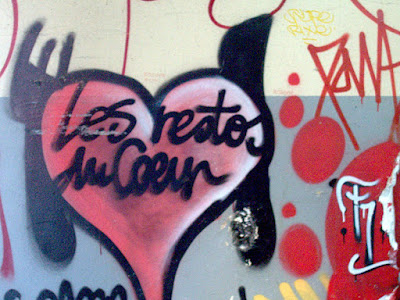 Blogger busted yesterday. So here's Saturday's graffiti on Sunday.
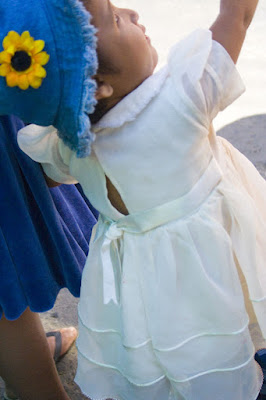 A candid shot of an Asian girl.
 Halloween costumed couple from a cruise that I took last year. Halloween costumed couple from a cruise that I took last year.Last year, I went on a cruise and snapped a picture of this lovely couple. I loved how they kept their costume so simple. Two masks and a couple of baseball caps. There was a great costume contest on board, but I had one complaint: There was not a piece of candy to find on board. Speaking of complaints. I cruised on the Norwegian Star, a line that, other than no candy on Halloween, I thought did pretty well. Not all agree with me here because here's one giant complaint. If I had a chance to go on a cruise on Halloween again, I sure would and I'd bring tons of every type of candy I could find and hand it out to all on the boat.
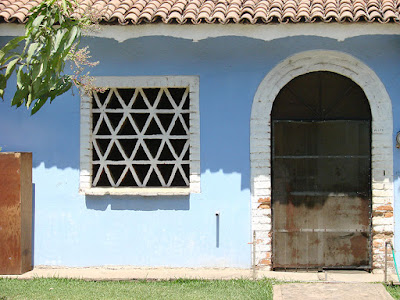 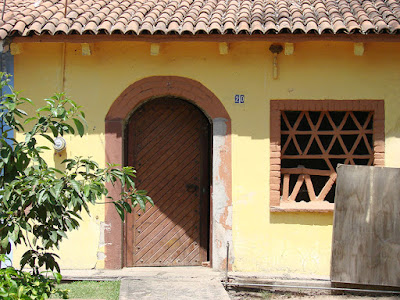 Photo sets can be found anywhere, these houses were next door to each other. Photo sets can be found anywhere, these houses were next door to each other.A photo set is when you match aspects of one photograph with that of another photograph or photographs. I’m sure you’ve been in hotels or restaurants that have a series of images—all related—on their walls. And…you probably also know that if you can sell one image that’s popular, you can sell many that are similar to it. Another useful element of creating photo sets is that matched photo sets on a Web page make it more readable when the photos are accompanied by text. There are many ways you can match your photographs with each other: 1. A butterfly, person, or any other subject shown from different angles in the same background. 2. Photos with the same hues and tones, perhaps taken in the same city at a certain time of year like Paris in the winter and even taken using the same camera settings. 3. Things things that are related to each other in some way such as a series of machines, radios, signs (of course!) and vintage autos. Check out the photos below, how are they alike. Please comment on them by clicking on the comments section below. Set 1Set 2Set 3Shooting while Moving Photo SetsA quick way to get a fast shutter speed is in within the auto modes of your camera. The picture of the running man (sports mode) will achieve remarkable results while you are moving in a plane, train or automobile. Don’t recommend that you shoot while you’re driving, but while you’re a passenger on a car, bus or plane, you can get some incredible photo sets using the sports mode auto setting. And if there’s no glare on the window you can keep the window closed. If you do the glass acts somewhat as a polarizing filter (a filter that blocks out UV light and haze, making for a clearer pic). Photoshop SetsIf you don’t have transparencies or photo filters, you can use the photo filters in Photoshop for a similar effect (Image>Adjustments>Photo Filter…) Filters in Photoshop work differently than those that you attach to your camera’s lens. With so many choices, menu bars, values, colors, and patterns to choose from, you might wonder why you even need a camera at all! As a photographer, though, I’m sure you want to work with your own images because in Photoshop, starting with your own exposures can let you create many effects from the same shot. When you apply some of the special effects of image processing programs, sometimes your image will appear to have lost resolution. Truth be told, some effects look no better than unwanted noise in your digital image. But then again, you might just craft an artistic view that is creative and compelling. Be very selective when using any filter in any image processing program because some filters work better than others. Some are meant to give your picture but a slight edge over the original. Many images sell with just this technique: that is, a simple image surrounded by a beautiful solid colored background. Photoshop has literally hundreds of effects (Filter>…) that you can use to finesse an image or recreate to another image for a photo set. The choices available range from subtle to dramatic to downright bizarre and surreal. How far you want to take your art photography from its original state is a matter of your taste and the outcome you desire. One of the most famous photographs of a child, Candy Store, Amsterdam Avenue New York (1954) was shot by William Klein (It can be viewed here.) The photograph shows a boy stooped down in front of candy store (both foreground and background blurred by the camera’s lens). Klein used blur to make images that some referred to as photography that didn’t meet up to standards of quality. Despite this, his work with blur became especially notable, and there’s a similar kind of blur that you can implement in your work using Photoshop.
 Inside a subway station in Paris Inside a subway station in ParisThe last time I wrote about the subway I recalled a station in Paris. In today's post I focus on the tunnel shape of the subway, because, after all, that what the subway is all about, traveling through a tunnel to go anywhere you want. In terms of photography, inside a subway is photo gold. You don't need a flash, because the white florescent light that glares everywhere under the ground is ample for photography. Finding the natural shape of the hole that has been dug underground is a hoot. You can shoot it from any angle and have an interesting shot. One of my favorite things to do in Paris is to get on the subway and get off at a stop that's picked randomly. Every time, I end up in a neighborhood filled with small shops, bakeries, meat shops and hot food shops. I eat my way into oblivion. I sometimes end up in an Arab part of town where lamb bakes on giant skewers and where the baklava is gooey with honey sticking to flaky crust. The reason I always end up in a really cool place no matter where I stop in the subway in Paris is because the city is divided into arrondissements, or sections that extend outward from the city's center. The arrondissements are numbered and each has a feature that's worth seeing. Here's a great description of each. Whether I find myself in the Latin Quarter (the 5ème arrondissement) or in the Champs Elysèe (8ème arrondissement); I always see, smell, taste, hear or touch something amazing, because the city of Paris, really, is one great big museum.
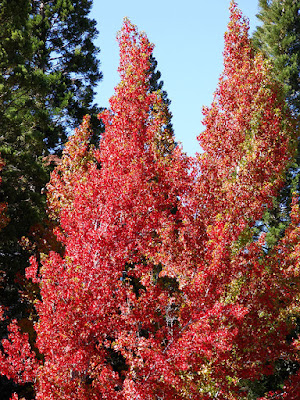 No flowers today. It's fall. Here's some changing leaves from Lake Arrowhead, CA.
Now that the chlorophyll is moving down the trees from the leaves to the trunk, and, eventually, down to the roots, the leaves are beginning to die.
During fall, a process whereby the sugar forming in the leaves intensifies during warm days and then stops during cool nights, so that more and more sugar is accumulated in the leaves.
The abundant sugar causes the leaves to change color. By the time winter comes when the days are cool and the nights cold, the sugar then travels down the branches to the trunk and eventually to the roots, so that the leaves fall and die.
Happy raking.
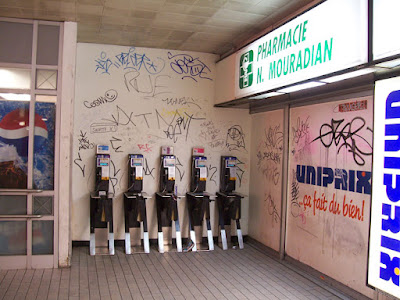 You say graffitti, I say grafiti, But the right way is graffiti, that would be graf-fi-ti, easy when you think about it. Well, it's here again--Graffiti Saturday, where I bring you the latest that comes out of the spray paint can or any other marker that's permanent. I found this week's especially interesting, more interesting than the post last month. There's not only some really bad marker art here, but there's also a row of phone booths below the scrawling. Stunning, actually, this photograph, because you've got some repetition among the people-made stick letters, which make the scene looks as if it could be stabbing you. There's not only dancing sticks here on the back wall. Look at the side wall, describe what you see in terms of color and patterns. Aren't photo descriptions fun!
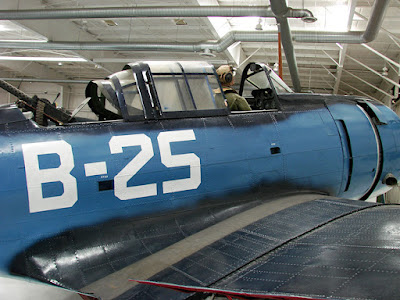 Check out the B-25 bomber, an airplane that's on display at the Palm Springs Air Museum. The place is filled with photo-ops. There are vintage cars, fire engines, and, of course, planes. First, a little about the bomber. The plane was accepted by the United States air force in 1945. It was never needed for battle during World War II, so, initially it was put into storage. It was later used for training missions in the United States. The Palm Springs Air Museum, displays World War II airplanes. There's a gift shop, library and two hangers in which the planes are displayed. A special plus is the number of WW II veterans who volunteer there. It's located 745 N Gene Autry Trail in Palm Springs, CA.
 Photo of photo from Palm Springs Air Museum Photo of photo from Palm Springs Air MuseumShe went from Shirley Jane Temple to Shirley Temple Black, quite a name shuffle over a life time.
Shirley Temple was born in 1928. She'll turn 80 next year.
Some of her life highlights include:
1. She appeared in her first movie when she was three.
2. She made Heidi in 1937.
3. In the movie, "On the Good Ship Lollypop," the ship was an airplane and not a boat.
4. As a teen, she attended Westlake School for Girls
5. Her stardom faded in the 40s--a teen has-been before she turned 18.
6. She reemerged in the 60s as a congressional candidate.
7. She married, becoming Shirley Temple Black.
8. She recovered from breast cancer in the 70s.
9. She went on to become ambassador to two countries.
10. She's alive and well at age 79.
 I always believed if you're going to teach something to somebody that's technical that you have to have fun with it. One way to do this in digital photography is to use the wild and wonderful images that you can find from day to day.
This one is a photograph of a drag queen in Palm Springs.
The best way to convert in Photoshop is the by using the Channel Mixer.
You could just desaturate (Image>Adjustments>Desaturate), but you have more flexibility by using the Channel Mixer's sliders.
Here's how you do it.
1. In Photoshop use Layer>New Adjustment Layer>Channel Mixer
2. Click okay in the New Layer dialog box.
3. Click on Monochrome in the Channel Mixer dialog box.
4. Tweak the slider bars till you get good contrast.
5. Use Layer>Flatten Image
 Photograph of man on stilts from my family's old photograph collection. Photograph of man on stilts from my family's old photograph collection. How often do you think of stilts? I don't much, but when I see them I smile. The last set of stilts I saw was at the Just for Laughs Festival in Montreal. Now, it wasn't until I started writing about this post that I've thought about just how high stilts can be. I was researching the beasts and found this. Evidently throughout history people have walked long distances on stilts as this man had. I think I've tried to walk on stilts a couple of times, but couldn't get up on the things. The size of people when they're walking in stilts can be up to 20 or more feet tall. The guy in this photo stands 11 1/2 feet from the bottom of the stilts to the top of his hat. Still, though, today, I'm crazy for stilts.
 Lake Arrowhead CA offers a lot for being a small town high up in the Southern California mountains. On weekends there are all kinds of events: craft fairs, bike races and boat shows. You also can hike, camp, swim and water ski. Try snow skiing in nearby Snow Valley, a great place to learn the sport. I went to Lake Arrowhead yesterday. It's about an hour and 20 minutes from Palm Springs, CA. With temperatures in the lower 60s, it was a great escape from the desert heat of Palm Springs. There's lots of good shopping in Lake Arrowhead, also. I went to Pendleton and bought a couple of short sleeve shirts for $20 each and a sports coat for a little over $80. I can't wait to go up there this winter to play in the snow.
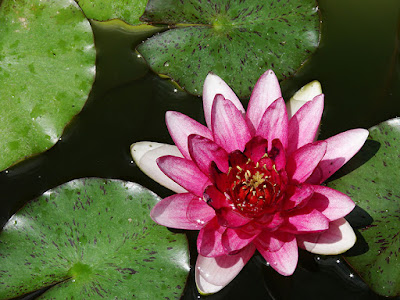 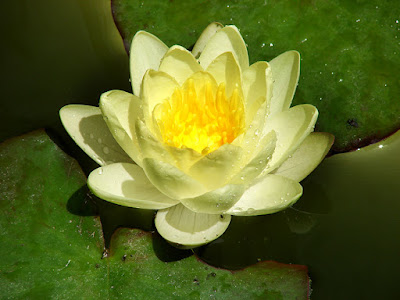 One from Asia; the other from California, so goes Lotus Sunday. Send me one of your flower photographs and I'll post next Sunday. For other flowers on my blog, check out-- flower 1flower 2flower 3 flower 4flower 5flower 6flower 7These are flowers from all over the world. Send to matthewbam@aol.com
 Spanish architect Gaudi had a style of his own. In the image above is a building in Barcelona, Spain that he designed. His signature style is a bit haunting at the same time as being festive, kind of like a Halloween carnival. Gaudi's work in the late 1800s was unique and based on nature with the use of carved stone and twisted iron. This type of arhitecture is referred to as organic because the shapes emulate free forms that you might see under the ocean, at the tops of trees or on the rocky cliffs near the beach. If your in Barcelona it's fun to walk the streets, spotting Gaudi's architecture.
 Photographing mosaics is probably the easiest photography you'll ever encounter. Just shut off your flash (provided there is some light), hold your camera as still as you can and shoot away in auto mode. (If there's little light use your flash.) Try zooming in close to isolate the objects that you like in the mosaic. Here's a mosaic from the Getty Villa in Malibu, CA. The Greeks constructed pebble mosaic streets with animal decorations 400 BC. In 200 BC the pebbles from which mosaics were so small, that after they were constructed, they could have been mistaken for paintings.
The mosaic above is Roman and probably of a subject celebrating a God.
 No travel photography blog would be complete without at least a brief mention of the country of Columbia. It's mysterious, a place where the words "judgement" and "fervor" come to mind. It's history goes back long before Columbus and extends to stories of drug cartels, trafficking and commerce. People in the United States, many of them, at any rate, would say Columbia is forbidden territory.
Others would have it that Columbia is full of exotic riches.
I'm with the later. I miss the place. It's unlike any other in the world.
 Underdog, my favorite cartoon character on TV via Photoshop Underdog, my favorite cartoon character on TV via PhotoshopOne of my favorite things to do is take pictures of old television sets and put campy things on the screen using the Edit>Transform tool in Photoshop.
In the picture above I took a picture television set that I snapped at Ruby's diner in Ft. Myers, FL and cleaned up the background.
 Then I slipped this image on top and transformed it so it fit inside the TV set. I've done this twice before on my blog, but with different images and television sets.
  Candid photography requires you to be quick.
I saw these two sisters in a van when I was in a small town in Mexico, just outside of Guadalajara.
I thought it was fascinating how the two girls and their parents agreed to let photograph (and were happy about it) from my perspective outside of the van window.
I thought the girls were not only pretty, but unique in that, when you first glance at them, you might be persuaded that they are twins. When you look at them a little longer, it's obvious that they're not. If you look closely, there are many differences between the two.
Candid photography is unique in that you can get away with small technical errors (some would disagree, saying any technical errors is not good photography). As you can see the lighting is off, but I like it because it really gives the atmosphere that you're inside some sort of vehicle with a brown interior.
 LA's Union Station is located within walking distance of downtown. LA's Union Station is located within walking distance of downtown.  LA's Union Station is the meeting point of many Southern California trains. LA's Union Station is the meeting point of many Southern California trains.The train station offers some of the most colorful stories of life in the moment. From Harry Potter waiting for a fantasy train on the way to new experiences in the Hogworts School to mom and kids going to grandma's house, the train brings tales of people meeting and greeting under a canopy of sights and sounds that air or automobile travel can't match. The sounds, sights and atmosphere of a train and inter-city stations offer travelers a unique experience, that far exceeds the seedy reputation that bus travel has. Even though the diesel inter-city Amtrak trains that exist in the United States aren't all that energy efficient, they are a bit more comfortable, scenic, and memorable. There's nothing like gazing out a picture window to see parts of the country where few have been and where roads are absent. Amtrak should have connected most cities in the United States decades ago with modern stations and on-time trains. But it hasn't. Neither have the high-speed electric inter-city trains that are common in Europe and Japan caught on in the U.S. This is due not only to the oil companies' manipulation of the American transportation system, but also to the regional political quagmires that have prevented capital from reaching those lowly rail stations in cities and towns all across America. Most are desolate places, lonely stops surrounded by scenic vistas and battered by the elements. One exception to this is Union Station in L.A., a busy place where many of the rail lines of Southern California end up. --From my article, "Is Train Travel History" at Utne.com
|
|



 2 ... 2 ...
2 ... 2 ...
































